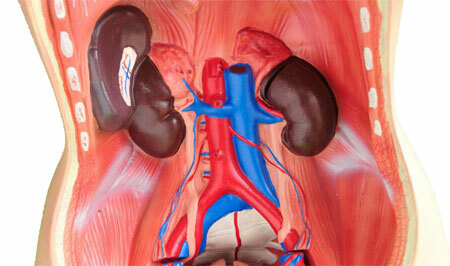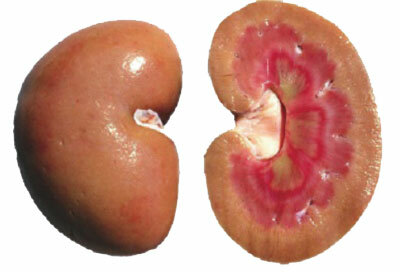What is kidney amyloidosis?
Amyloidosis is an infrequent disease that develops in the case of the deposition of amyloid proteins in tissues and organs. Amyloid proteins are pathological proteins that the body can not process and use.
The pathogenesis of the disease consists in the coalescence of amyloid proteins with the formation of the same deposits, damaging various tissues and organs. Most often the disease affects the kidneys, heart, nervous system, liver and digestive tract.
Contents of
- 1 The causes of amyloidosis of the kidneys
- 2 Symptoms and signs of amyloidosis of the kidneys
- 3 Diagnosis of amyloidosis of the kidneys
- 4 Treatment of amyloidosis of the kidneys
- 4.1 Features of the
nutrition Causes of amyloidosis of the kidneys

Amyloid accumulation in the kidneys can result in deposits of various proteins, but not all of them cause problems withhealth. Types of protein determines the types of amyloidosis to which the following belong:
- Primary amyloidosis of the kidneys - develops for no known reason, more often in people with blood cancer( multiple myeloma).This is the most common type of amyloidosis, in which the kidneys are most often affected. This type of kidney function is disrupted, which causes kidney failure, leading to increased blood pressure, bone disease and anemia.
- Secondary amyloidosis of the kidneys - develops as a result of other chronic inflammatory diseases - systemic lupus erythematosus, certain types of cancer, rheumatoid arthritis, Crohn's disease and ulcerative colitis, tuberculosis. Most often affects the kidneys, spleen, liver, adrenal glands and lymph nodes.
- Dialysis-associated amyloidosis is more common in the elderly and patients on dialysis for more than 5 years. This form of amyloidosis, although it develops most often due to kidney disease, affects bones, joints and tendons.
Symptoms and signs of amyloidosis of the kidneys

The most common symptom of kidney amyloidosis - nephrotic syndrome - is a combination of symptoms that indicate damage to the kidneys and a violation of their proper functioning. Symptoms of a nephrotic syndrome include:
- Albuminuria is an increased amount of albumin in the urine.
- Hyperlipidemia is a condition in which the patient's blood rises in fat and cholesterol.
- Edema - are observed, as a rule, on the feet and legs of a person, less often - on the hands or face.
- Hypoalbuminemia is an inadequate amount of albumin in the blood of a person( it is excreted from the body through the kidneys).
Other symptoms of renal amyloidosis may include:
- fatigue, weakness;
- shortness of breath;
- decrease in blood pressure;
- numbness or burning sensation in the hands or feet;
- weight reduction.
Diagnosis of kidney amyloidosis
Doctors diagnose a pathology with:
- finding out medical and family history;
- physical examination;
- urine tests;
- blood tests;
- kidney biopsy.
Medical and family history of
An anamnesis history helps the doctor diagnose and can determine the presence of amyloidosis in relatives, the presence of chronic diseases in the patient that could lead to the development of the disease.
Physical examination
During the examination, the doctor, as a rule:
- examines the patient for the presence of edema;
- performs auscultation of the lungs;
- performs palpation of organs.
Urinalysis
In the urine, the presence of albumin and amyloid protein is determined, the elevated content of which may indicate amyloidosis of the kidneys.
Blood tests
Blood tests determine the functioning of the kidneys, the presence of amyloid proteins and hyperlipidemia.
Biopsy of the kidneys
Only with the help of a biopsy discover the accumulation of amyloid in the kidneys. This procedure consists in taking a piece of kidney tissue, it is carried out under the control of ultrasound or computed tomography. The tissue is then studied in detail under a microscope to determine amyloid proteins and the causes of kidney damage. The results of a biopsy help the doctor determine the best course of treatment.
Treatment of amyloidosis of the kidneys

Unfortunately, it is impossible to cure such a disease as amyloidosis of the kidneys. In the primary form of the disease, therapy is prescribed, suppressing the development of amyloid proteins, and helping to control the symptoms of the disease. In secondary amyloidosis of the kidney, treatment also includes therapy for the underlying disease.
Treatment of primary amyloidosis of the kidneys
Primary amyloidosis of the kidney is treated with:
- Specific drugs( melphalan, dexamethasone) that stop the growth of cells synthesizing amyloid proteins. Drug therapy is to some extent effective in about two-thirds of patients. These drugs sometimes cause adverse effects, such as nausea, vomiting and fatigue.
- Stem cell transplantation - this procedure replaces damaged cells of the patient with healthy ones. This therapy is administered to people younger than 70 with little heart failure. Before the transplantation of the stem cells, the patient is given chemotherapy to prepare for the procedure.
- Treatment of other diseases - since primary amyloidosis can not be cured, it is sometimes necessary to correct complications, which include anemia, depression, fatigue.
In later stages of amyloidosis, patients undergo kidney transplantation. Although the disease can re-evolve in the donor organ, some recipients feel well enough and live up to 10 years.
Features of nutrition
Although the researchers found no role for nutrition in the development or prevention of amyloidosis of the kidneys, people with nephrotic syndromes are recommended:
- Limit sodium intake, which helps to reduce swelling and lower blood pressure.
- Reduce water consumption.
- Observe a diet low in saturated fats and cholesterol.
Doctors also recommend that patients with kidney disease reduce the amount of protein in their diet. Proteins are split into substances that the kidneys must remove from the blood, so increased use of them can lead to an acceleration of impaired renal function.



